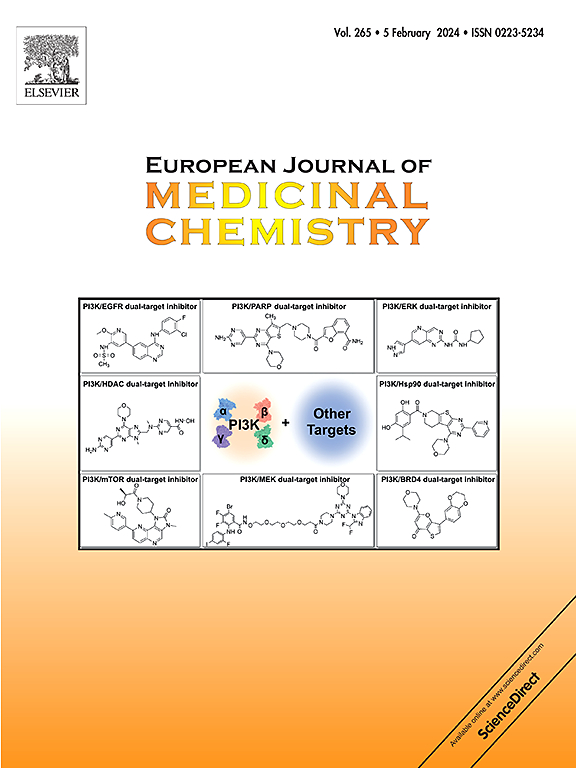Design, synthesis and biological evaluation of novel 4-(thieno[3,2-d]pyrimidin-4-yl)morpholine derivatives as potent antitumor agents
IF 6
2区 医学
Q1 CHEMISTRY, MEDICINAL
引用次数: 0
Abstract
A series of 4-(thieno[3,2-d]pyrimidin-4-yl)morpholine derivatives were designed, synthesized and evaluated for their in vitro inhibitory activities against PI3Kα and antiproliferative activities against PC-3, 22RV1, MDA-MB-231 and MDA-MB-453 cancer cell lines. Inhibitory activities against PI3Kα evaluation indicated that some compounds showed excellent PI3Kα activity in vitro, and IC50 values of eight compounds (17c, 17e, 17f, 17h, 17l, 17m, 17o, 17p) were less than 100 nM. The most promising compound 17f (PI3Kα: IC50 = 0.039 μM) showed remarkable antiproliferative against PC-3, 22RV1, MDA-MB-231 and MDA-MB-453 cell lines with IC50 values of 3.48 μM, 1.06 μM, 2.21 μM and 0.93 μM, respectively. Furthermore, 17f effectively reduced p-PI3K protein expression and inhibited the activation of downstream signaling AKT and mTOR proteins in MDA-MB-453 cells. In addition, 17f induced cell apoptosis by down-regulating the expression levels of anti-apoptotic proteins Bcl-XL and Bcl-2 and up-regulating the expression of anti-apoptotic protein BAX, and in MDA-MB-453 cells. All these results indicated the potential of compound 17f to develop as potent anticancer agent.


新型4-(噻吩[3,2-d]嘧啶-4-基)啉衍生物的设计、合成和生物学评价
设计、合成了一系列4-(噻吩[3,2-d]嘧啶-4-基)啉衍生物,并测定了其对PI3Kα的体外抑制活性和对PC-3、22RV1、MDA-MB-231和MDA-MB-453癌细胞的体外抑制活性。体外抑PI3Kα活性评价表明,部分化合物具有较好的PI3Kα活性,其中8个化合物(17c、17e、17f、17h、17l、17m、17o、17p)的IC50值均小于100 nM。最有希望的化合物17f (PI3Kα: IC50 = 0.039 μM)对PC-3、22RV1、MDA-MB-231和MDA-MB-453细胞株的IC50值分别为3.48 μM、1.06 μM、2.21μM和0.93 μM。此外,17f有效地降低了MDA-MB-453细胞中p-PI3K蛋白的表达,抑制了下游信号AKT和mTOR蛋白的激活。此外,在MDA-MB-453细胞中,17f通过下调抗凋亡蛋白Bcl-XL和Bcl-2的表达水平,上调抗凋亡蛋白BAX的表达,诱导细胞凋亡。这些结果表明化合物17f作为一种有效的抗癌药物具有发展潜力。
本文章由计算机程序翻译,如有差异,请以英文原文为准。
求助全文
约1分钟内获得全文
求助全文
来源期刊
CiteScore
11.70
自引率
9.00%
发文量
863
审稿时长
29 days
期刊介绍:
The European Journal of Medicinal Chemistry is a global journal that publishes studies on all aspects of medicinal chemistry. It provides a medium for publication of original papers and also welcomes critical review papers.
A typical paper would report on the organic synthesis, characterization and pharmacological evaluation of compounds. Other topics of interest are drug design, QSAR, molecular modeling, drug-receptor interactions, molecular aspects of drug metabolism, prodrug synthesis and drug targeting. The journal expects manuscripts to present the rational for a study, provide insight into the design of compounds or understanding of mechanism, or clarify the targets.

 求助内容:
求助内容: 应助结果提醒方式:
应助结果提醒方式:


